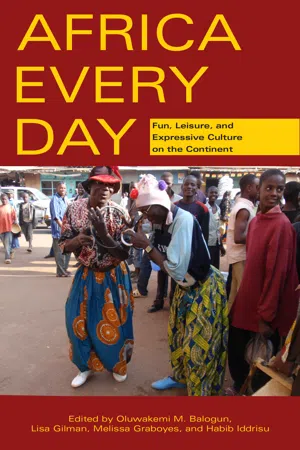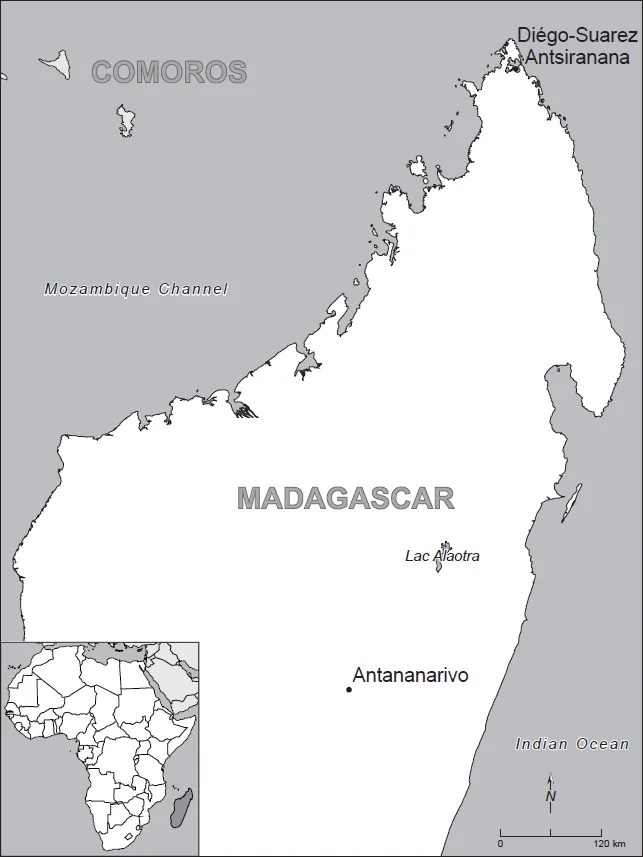![]()
Part 1
Celebrations and Rites of Passage
![]()
Map 1.1. Madagascar. Map by Christopher Becker.
1
Hosting a First Haircutting in Diégo Suarez, Madagascar
ERIN NOURSE
This chapter explores the social and ritual dimensions of a Malagasy baby’s aqiqah, an Islamic welcoming ceremony. This ethnographic account of a university student’s hosting of an aqiqah is based on research conducted from September 2011 to June 2012 on birth rituals and rites of initiation for the newly born in Diégo Suarez, Madagascar, where I lived with my husband, Ben. I interviewed approximately fifty informants in Malagasy and French, or a combination of the two, as Malagasy often code-switch (i.e., alternate) between the two languages. A few interviews were conducted in English. I also attended religious ceremonies and participated in typical Diégo everyday activities. All participants’ names are pseudonyms.
Parents living in pluralistic urban contexts such as Diégo Suarez, a port city at the northernmost tip of Madagascar, use the birth of a child to contemplate and construct complex family histories and religious identities—their own, as well as those they wish to instill in the emerging life of the newly born. Such celebrations offer participants the space to discuss concerns regarding the appropriateness of certain religious practices, race and identity issues, and what it means to be Malagasy.
In places like Diégo, where many live far from their ancestral homelands (tanindrazana) and extended kin, rites for newborns are sometimes creatively invented by an increasingly diverse and aspirational generation of young people. These and other “traditional” rituals are traditional only in the broad sense of the word, in the way that most of us cast our ritual innovations as linked with the models from our past. They are informed by Malagasy family customs in addition to encounters with social difference, as Christians, Muslims, and traditionalists increasingly include one another in their religious festivities.
Traditions of Haircutting in Madagascar
Madagascar, the fourth-largest island in the world, lies in the Indian Ocean off Africa’s southeast coast. It is known for its biodiversity. However, as home to peoples of African, Asian, and Arab descent, its cultural diversity is equally captivating. Travelers have long been intrigued by Malagasy practices of ancestor veneration; in particular, the burial and reburial (exhumation) customs of the Merina of the central highlands have been well documented.1 By contrast, this essay examines beginning-of-life ritualizing activities among northern coastal groups. I highlight haircutting, in the context of a baby’s aqiqah, as one of the ways Malagasy introduce the newly born to the obligations they have as descendants of ancestors—the customs (fady), taboos (fomba), and ritual practices that make them who they are today.
In Madagascar, it is common to cut or shave a young child’s hair. Sometimes, haircutting is part of a ceremony or rite of passage; other times, it is simply part of an infant’s conventional everyday care. While the origins are unclear, we know ritual practices in honor of birth are more than a few generations old.2 Haircutting traditions of Madagascar’s early Indonesian, East African, and Arab Muslim inhabitants likely contributed to contemporary practices. Some trim their children’s hair a few days after birth as part of a traditional blessing (joro) or in conjunction with the Islamic practice of holding a sacrifice seven days after a birth (aqiqah); others shave babies’ heads at multiple points during infancy; and some perform haircutting ceremonies once a child has cut its first teeth, at a ceremony called mampiravaka tsaiky (literally: to bejewel the child) where children are adorned with heirloom necklaces that link them to those—both alive and gone—who have worn the same jewels.3
In rituals, haircutting cleanses the child of any pollution (maloto) she or he might have acquired while passing through the birth canal, socializes the child, and transitions infants from something ambiguous to a fully integrated human. Haircutting cuts across religious communities and ancestral lineages, with specific prayers, food, and ritual objects shaping the child in distinct ways. Haircutting is rarely performed in isolation from other cultural and religious practices such as naming ceremonies, baptisms, sacrifices, circumcisions, and traditional ancestral blessings (joro), which also shape children’s identity, but it is nevertheless an important means by which Malagasy instill what it means to be Malagasy and a member of a community.
Situating Diégo Suarez, Madagascar
Named after two Portuguese explorers said to have discovered the island in 1506, Diégo Suarez is the capital city of the northernmost province of Madagascar. A heterogeneous cosmopolitan port city, it has many lures, including a large university, teaching hospital, military base, naval shipyard, fish processing plant, and several administrative centers. Diégo has a long history of enticing people to its shores—longer than is implied by the so-called Portuguese “discovery” of Madagascar in the sixteenth century.4
When I returned in 2011, the third time since 2004, Diégo’s streets were lined with hurricane-damaged French colonial-era buildings and shiny new tourist hotels. Pedestrians, cyclists, motorists, yellow taxis, children in school uniforms, chickens, stray dogs, and street vendors selling mangoes, pickled mango chutneys, and sambos and other fried treats crowded its streets. The city’s inhabitants included Malagasy from all over Madagascar as well as Indo-Pakistani immigrants, Comorians, Yemini Arabs, and French expatriates.
Celebrating the Birth of Hakim
In January 2012, Ravaka and Nasreen stopped me at the University of Antsiranana’s library. Nasreen wore a long blouse, skirt, and hijab (head scarf), and Ravaka wore a T-shirt and jeans. They shared that Nasreen’s friend had given birth and would host an aqiqah, the Islamic tradition of sacrificing an animal at the occasion of a birth. “We’re still looking for the goats,” Nasreen explained. “If we find the goats in time, the ceremony will take place this Saturday.”
At seven a.m. on Saturday, Nasreen and her neighbor, Khalisah, were preparing food for the ceremony. On the concrete porch that encircled their dormitories, they sorted rice, looking for tiny stones. As guests arrived, women congregated around the rice, children played tag in the courtyard, and men readied the space for the slaughtering of the goats. In anticipation, Nasreen’s five-year-old son Aasim began to cry, which prompted Nasreen to escort all the children inside for a dessin animé (cartoon). Outside, in accordance with the customs of halal, the prescribed method of slaughter for Muslims, men prayed over the animals, laid the goats to face Mecca, and, with a quick slice of a knife across their jugular veins, spilt their blood upon the ground. Aasim reemerged, deeply curious about the men’s work. Across the courtyard, women prepared the feast. One scraped out the inside of a coconut and then pressed water through the shredded coconut meat. Others cut goat meat, sliced cucumbers for a salad, and peeled potatoes for the stew.
Figure 1.1. As part of his aqiqah, an Islamic welcoming ceremony, baby Hakim receives his first haircut. With her three-year-old daughter looking on, Nasreen, the host of the ceremony, carefully snips away Hakim’s hair as he lies in his mother’s lap. Source: Erin Nourse.
At midmorning, the newborn guest of honor, asleep and bundled in blankets, arrived in an interior room where the haircutting would take place. Rahimah held her tiny infant Hakim as Nasreen cut his hair by gracing his scalp with ordinary household scissors while he slept. Few observed this intimate procedure, save a couple of women and a handful of children. Only once did he cry, provoking his mother, who wore a long dress and hijab, to unabashedly pull her clothing aside to console him. As he suckled, Nasreen removed the remainder of the downy hair that covered his head.
Nasreen gathered the handkerchief she had used to collect the hair, shook it into a piece of white paper, rolled it up, and handed it to a man standing in the doorway. The hair would be weighed at a local épicerie (small grocery), and gold would be bought in proportion to its weight. They would give the gold to the poor, as a token of gratitude for the child’s birth. Though the baby was unaware of the ceremony on his behalf, other children were not. They were in and out of the room, tried to touch the baby, and observed with infectious grins.
The meal was served unceremoniously. Unlike some haircutting events, no ritual speeches (joro) or requests for blessings from the ancestors were made. Instead, the gathering was casual. The sixty or so guests were relatives, friends, and schoolmates—part of the community to which baby Hakim now belonged. The attendees were diverse in age, religion, and nationality. Adult members of the Muslim community ate indoors in separate spaces according to their gender, while young children, regardless of gender, shared their own space outside.
Children changed into the gorgeously decorated religious dress, complete with hijab and hats (taqiyah). Ben, my research assistant Édith, and about a dozen of Nasreen’s non-Muslim friends gathered around a table on the outdoor thatched patio. We sat in chairs and were given plates, forks, and spoons, while Muslim participants ate on the floor with their hands from communal silver platters atop traditional Malagasy eating mats (lamaka). The rice was seasoned with coconut milk and cinnamon accents and tasted of the fire on which it had been cooked, a taste distinct from that of rice cooked over gas or charcoal for more common, nonreligious occasions.
Those at our table discussed the goat meat. Some didn’t typically like goat because “it smelled,” but they liked how Muslims cooked it in a curry sauce with turmeric, onion, garlic, tomato sauce, and potatoes. Osman, a gregarious Muslim and an international student from the Comoros, an island country to the northwest of Madagascar, sat at the table with the non-Muslims. Telling jokes, he code-switched between Malagasy, English, French, and Comorian Swahili. Some found his use of Comorian Swahili amusing, given that the northern dialect of Malagasy has enough Swahili borrowings to make his language sound simultaneously strange and familiar.
Osman complained about burqas, loose outer garments some Muslim women wear to cover their entire bodies in public (as opposed to hijabs, which typically cover just the hair and neck), and about Malagasy perceptions of Comorians. He argued that Muslims who dress in burqas are “adding to,” or perhaps altering, the traditions of the Prophet and his wives. He seemed well versed in the theological arguments against wearing burqas, but less so in the religious rationale behind some Muslims’ decision to do so. He appeared embarrassed that Muslims who wear burqas in Madagascar are usually thought to be Comorian, since he viewed such garments as sinful. “Sometimes,” he countered forcefully, “they are pure Malagasy.” He also complained that most Malagasy think Comorians are “very black.” Others concurred that they used to think this, too, but agreed that Comorians come in all shades and dress in various styles, “just like Malagasy.” “Though, to win the Miss Comorian contest,” Omar explained, “you have to have very black skin and you have to have curly hair. We have to stand up for ourselves,” he proclaimed, designating dark skin as a source of pride.
Figure 1.2. Two men work together to slaughter two goats accordin...



